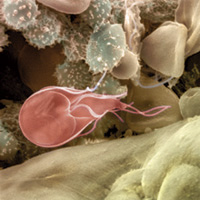Turning Discovery Into Health
Global Health

Science and disease have no borders, and thanks to NIH-funded research by U.S. and international teams, scientists have made important progress in both infectious and chronic, non-communicable diseases that affect people across the globe.
Scientists now have modern research tools and an ability to read the genetic language of disease-causing bacteria, viruses, and parasites. These advances are leading to totally new approaches for combating well-known threats like malaria, tuberculosis, and HIV/AIDS. Scientists are also learning more about the microorganisms that cause “neglected” diseases, so-named because they’ve gone understudied for many years, although they sicken or kill billions of people worldwide.

Giardia lamblia (pink) is a single-celled parasite that causes giardiasis, an intestinal disease marked by abdominal pain, diarrhea and nausea. It is spread through contaminated food and water and is most common in tropical regions.
According to the World Health Organization, diarrheal disease kills 1.8 million people every year. By far, most of this burden is caused by unsafe water supply, sanitation, and hygiene. Children in developing countries are hit especially hard by these diseases. NIH-funded research on prevention and treatment of diarrheal diseases like cholera and rotavirus has made vital contributions to public health throughout the world.
Chronic non-communicable conditions like cancer, heart disease, and obesity contribute to more than half of all deaths in the developing world. NIH is committed to mitigating this developing catastrophe by providing not only needed financial and human resources, but also in fostering teamwork between scientists, health organizations, and regional governments.
Imagine the Future…
- New technologies diagnose tuberculosis in a few minutes and predict the right drug for the right patient.
- A malaria vaccine prevents more than a million deaths a year in the developing world.

 HIV/AIDS
HIV/AIDS Influenza
Influenza Global Health
Global Health
Social Media Links